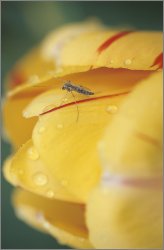The New Dangerous Tropical DiseaseHitting U.S. Shores:
Chikungunya
by www.SixWise.com
Chikungunya, a mosquito-borne virus native to Asia and Africa,
has made its first appearance on U.S. shores, with at least
a dozen cases showing up in six or more states, including
Colorado, Louisiana, Maryland and Minnesota.
|

Chikungunya is spread by mosquitoes -- primarily by
varieties that live in tropical locations.
|
The virus, which was discovered in East Africa in the 1950s,
has caused only 18 major epidemics and was thought to be largely
benign; however, chikungunya appears to be making a comeback.
Most notably, in India and islands in the Indian Ocean over
1 million cases have been reported since 2004, and cases have
been found in Europe and the United States since 2005.
"This virus has exploded," said French scientist
Philippe Parola. "People must start to pay attention."
Chikungunya: An Arthritic Virus
Chikungunya is Swahili for "that which bends up,"
a phrase that aptly describes people infected with the virus.
Chikungunya causes severe muscle and joint pain (which is
why it's classified as an arthritic virus), along with:
- Fever
- Headache
- Rash
- Nausea and vomiting
- Fatigue
Although chikungunya is rarely fatal, joint pain can last
for weeks or months, and sometimes is incapacitating during
this time.
"For us [in France], chikungunya fever was a few lines
in a tropical medicine book," said Parola. "Now
we see many cases and have noticed that after nine months
half the patients are cured, but half still have severe arthritis,
especially in their hands, wrists and ankles."
Currently, the only way to prevent chikungunya is to avoid
being bitten by a mosquito. Those who become infected are
advised to rest and drink plenty of fluids.
|

Chikungunya is classified as an arthritic virus because
it can cause debilitating joint and muscle pain.
|
How is Chikungunya Spread?
You can get chikungunya by being bitten by an infected mosquito.
Mosquitoes pick up the virus from feeding on infected humans,
and likely also from infected animals including monkeys. Although
the virus is not generally spread from person-to-person, there
is at least one report of a nurse becoming infected from a
patient's blood sample.
Is an Epidemic Possible?
Chikungunya is transmitted primarily by mosquito species
native to tropical areas, not the more common house mosquitoes
found across the United States (which can transmit West
Nile virus). Because of this, some say a chikungunya epidemic
is unlikely in the United States.
"Chikungunya could enter someplace like Miami and maybe
cause a localized epidemic, but it's unlikely to establish
itself long term," said Dr. Grant L. Campbell, a medical
epidemiologist with the Centers for Disease Control and Prevention.
"But it could establish itself in a place like Honduras."
However, with international travel becoming increasingly
popular (three-quarters of a billion people travel internationally
every year, according to the World Tourism Organization),
others say chikungunya could very well become a global disease.
"Is there a threat that an infectious patient can meet
a competent vector [mosquito] in the U.S. and Europe? Why
not?" said Parola. "We still don't know how it gets
established, though. And we don't know the future if that
happens. But is there a risk? Yes, there is a risk."
Others say that chikungunya is just the next inevitable disease
to pop up throughout an increasingly small world.
"Are we going to keep seeing the next emerging disease?
That's how we've set ourselves up," said Emily Zielinski-Gutierrez,
a behavioral scientist at the National Center for Infectious
Diseases. "We're close to everywhere else in the world,
and we need to understand what's going on everywhere. People
are moving; their food comes from all over. This is a small
world."
Recommended Reading
The
Rise of Contagious Disease & How to Minimize Your Risk
of Contagious Disease Exposure
Bugs
that Bite: Interesting Facts & Necessary Precautions on
the Insects That Crave You
Sources
Newhouse
News Service November 22, 2006
The
New York Times October 10, 2006 (Free Registration Required)
CDC:
Chikungunya Fever